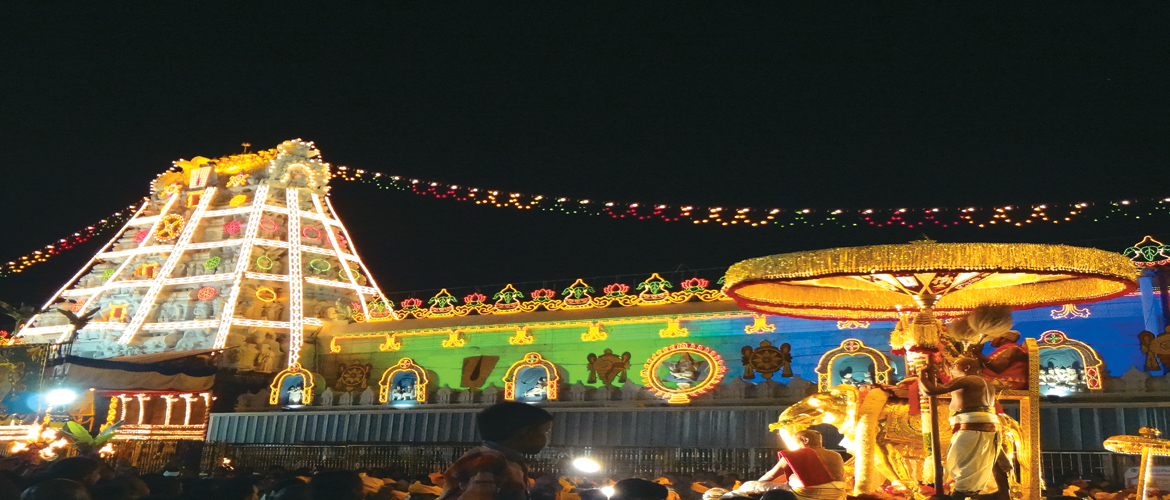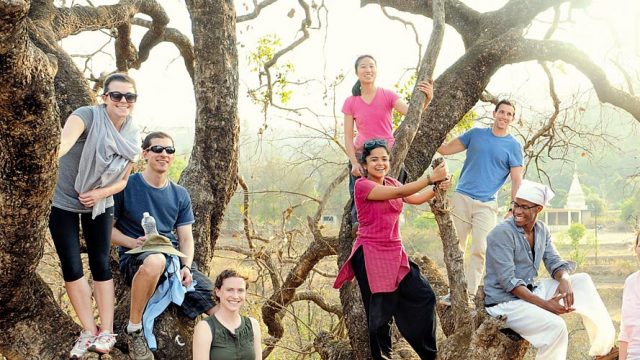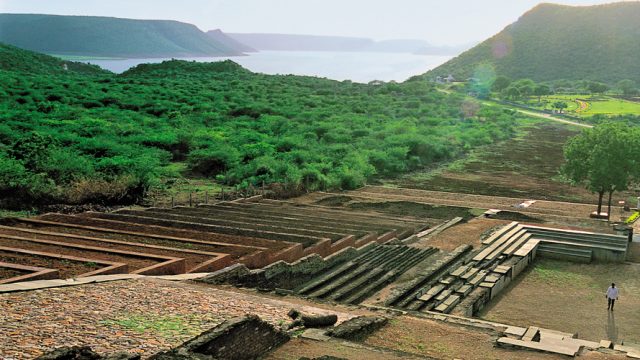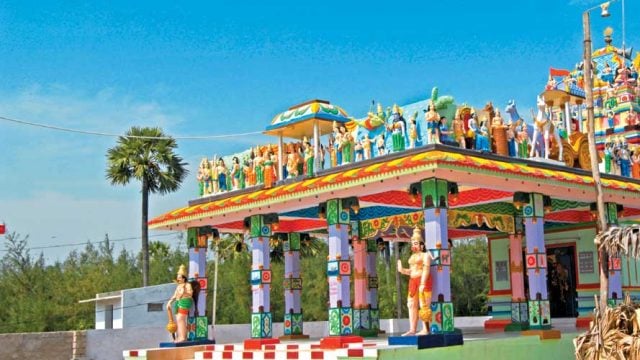Type Religious Festival Time 9 days in October Location Tirumala, Andhra Pradesh There are
Lord Vishnu, in his incarnation as Srinivasa, is said to have married Padmavathi, a princess reincarnate of Goddess Lakshmi. He later settled down in the seven hills to save humanity from the evils of Kali Yuga (the era of vice). It is believed that Srinivasa, whose marriage to Padmavathi was blessed by all the gods, had to borrow money from the lord of wealth, Kubera, for the wedding expenses. And to this day, devotees are repaying the debt by making offerings to the deity’s hundi (donation box). Hence, he is also known as Vaddi Kasulavaadu (lord of money). A devotee called Rangadasu later constructed a temple for Sri Venkateswara, Padmavathi and other deities. The descendants of Sage Vaikhanasa perform prayers at the shrine.
The temple has rituals, festivities and celebrations not just throughout the day, but practically on every day of the year. Some of the most prominent ones are Koil Alwar, Pushpa Yagam, Tirumanjanam, Aasthanam, Vasantotsavam, Parinyotsavam, Vaikuntha Ekadashi, and Jyeshtabhishekam. But, what really showcases the pomp and colour associated with the Vaishnavite shrine is the annual Brahmotsavam. Vishnu, it is said, is alankara priya (fond of decoration and embellishment) and the festival is an occasion to celebrate the deity with unparalleled grandeur.
The number of devotees that throng the temple on regular days runs into thousands and goes up to lakhs on special days such as Brahmotsavam, Vaikuntha Ekadasi and Ratha Saptami. It is said that the name Brahmotsavam comes from the belief that Brahma himself first performed the rituals that are today conducted over nine days. The festival features religious processions through the streets of the temple complex, with the idol decked as a specific incarnation, riding a different vehicle each day.
It begins with the Ankurarpana (sowing) of the navadhanyas (nine kinds of seeds that are consecrated as offerings to the navagrahas, celestial bodies in Hindu astrology). These are planted in nine mud pots over nine days. The next ritual is Dhwajarohanam, where a piece of cloth painted with the image of Garuda is mounted high on a pillar (Garuda Dhwaja). The fluttering flag is deemed to be the invitation for the gods to attend the Brahmotsavam. It is said that 30 million deities accept the invite and descend upon the seven hills. Thus, the occasion is considered highly auspicious.

Lord Venkateswara is taken out on the Pedda Sesha Vahana, the vehicle representing the serpent on which the deity rests in ksheera sagara (celestial ocean of milk). This is followed by the Chinna Sesha Vahana, which symbolises the small snake that adorns the neck of Shiva. On subsequent days, the deity is taken out in processions through the streets around the main temple on different vahanas (vehicles). The Hamsa Vahana is the swan vehicle, which signifies a ray of light in the darkness of ignorance. The Simha Vahana represents a mighty lion. Mutyapu Pandiri (pearl-adorned), Kalpavriksha (tree of boons) and Sarva Bhoopala (gods of the earth, air and water) vahanas signify the supremacy and benevolence of the lord. The next few days see the Mohini (the female form of Vishnu), Garuda (eagle), Hanumantha (Hanumana) and Gaja (elephant) vahanas.
The temple follows the Aagama traditions in rendering the various rituals in colourful detail and glory. The streets, flanked by galleries for devotees to sit and watch the procession of the almighty, reverberate with devotional music rendered by renowned singers. Classical dancers and folk artistes also hold performances. Thousands of volunteers, along with the 20,000 employees of the temple, help run the festival smoothly, without any untoward incident.
On the seventh day of Brahmotsavam, Sri Venkatesa is dressed in red clothes and taken out in a procession on the Surya Prabha chariot, which represents the sun-like radiant nature of the deity. At night, he is dressed in white, decorated with jasmine flowers and paraded on a white Chandra Prabha vehicle that signifies the god’s moon-like cooling nature. On the next day, the deity takes a ride on a golden chariot and horse. After eight days of continuous festivities, the Lord and his consorts are given a holy bath known as Chakra Snanam to help them rejuvenate. This is also an occasion for devotees to take a holy dip in the pushkarini (temple tank). After the ritual, the Brahmotsavam draws to a close and the Garuda Dhwaja flag is brought down to mark the end of celebrations.

There is a popular saying in Andhra Pradesh: Venkatadri samasthanam brahmande nasti kinchanaha (There is no place like Tirumala and there is no God like Lord Venkateswara). And indeed, visiting the temple during Brahmotsavam is an unrivalled experience – the tide of devotion, amidst the colourful and joyous rituals, is sure to engulf you, regardless of your faith.
WHERE TO STAY
Despite the endless crowds that throng the town during the festival, the innumerable hostels, hotels and pilgrim guesthouses run by the Tirumala Tirupathi Devasthanam are usually sufficient to accommodate the crush of devotees.
Tirumala Tirupati Devasthanam (TTD) provides comfortable accommodation for pilgrims at reasonable rates. There are many guesthouses, cottages and choultries, both at Tirumala and Tirupati. Rooms are available in all budgets and also for free. Reservations can be made online at W ttdsevaonline.com (Tel: 0877-2233333, 2264217; Tariff: ₹500–3,000).
Tirupati has a greater variety of accommodation as compared to Tirumala. ITC’s Fortune Kences (Tel: 0877-2255855, Cell: 09396655855; Tariff: ₹3,500–7,000), located opposite the bus stand, has clean rooms, although the service can be a bit tardy. Marasa Sarovar Premiere (Tel: 6660000, 2282001, Cell: 07660006545; Tariff: ₹4,400–8,000) has two restaurants, a spa, gym and swimming pool. Fortune Select Grand Ridge (Tel: 2221818, Cell: 09701343010, 09701353005; Tariff: ₹4,200–25,500) is a luxurious 5-star hotel with a poolside bar and spa. Ramee Guest-line Hotel (Tel: 2280800, 2281572, Cell: 09505500053; Tariff: ₹3,500–5,500), Bhima’s Paradise (Tel: 6577271, 2237271-72, Cell: 09290427028; Tariff: ₹999–2,200), Hotel Woodside Tirupati (Tel: 2284464, Cell: 09494598463, 09490636733; Tariff: ₹900–2,500), Hotel Sindhuri Park (Tel: 2256430-31, Cell: 09494513337/ 31; Tariff: ₹2,340–3,699) and Aditya Residency (Tel: 2252277, 2224799, Cell: 08297038111; Tariff: ₹1,800) are other good hotels.
WHERE TO EAT
There are plenty of restaurants and small eateries in Tirupati as well as Tirumala. Most hotels have their in-house restaurants. Fortune Select Grand Ridge in Tirupati serves a variety of cuisines at their restaurants – Zodiac, Rainbow and Neptune Bar. Ramee’s Maurya is a multi-cuisine eatery. The restuarant at Hotel Mayura offers sumptuous meals. Nine Flavours has delectable food, good service and a pleasant ambience. Hyderabad House is a chain restaurant that offers delicious vegetarian and non-vegetarian meals. Andhra Spice serves excellent Andhra cuisine.
In Tirumala, only vegetarian food is served and alcohol is not allowed. Free meals are provided to pilgrims every day at the Nitya Anna Dana Hall. Sarangi, which serves both north and south Indian cuisine, is regarded as one of the best in Tirumala. Annamaya and Woodside are other decent options.
FAST FACTS
Festival Organiser
Tirumala Tirupati Devasthanam
TTD Administrative Building
KT Road Tirupati
Tel: 0877-2233333, 1800425111111
Tourist Office
APTDC Tourist Info Counter
Sridevi Complex, Tilak Road
Tirupati
Tel: 2289120
STD code 0877
GETTING THERE
Air Tirupati Airport (11km/ 45min) is located at Renigunta and has flights from Hyderabad, Vizag, Delhi, Chennai and Bengaluru. Taxis can be hired for Tirumala for about ₹1,500. Alternately, take a taxi to Tirupati Bus Stand (₹450) from where you can get onto a Tirumala-bound bus (₹45)
Rail Tirupati station is served by trains from Hyderabad, Bengaluru and Chennai. The bus stand is about 1km east of the station
Road By car, it’s a 3-hr drive from Chennai. If your car breaks down on the ghat roads, you can call 0877-2263636 for immediate help. A mechanic will be sent in a mobile van equipped with spares Bus Chennai’s MBT Bus Stand has services to Tirupati. APSRTC runs free buses from the Tirupati Railway station to Alipiri every 30mins. Pilgrims who plan to walk to Tirumala can use this service. Tirumala-Tirupati bus ticket ranges from ₹45 (adults) to ₹23 (kids). During the festival, APSRTC runs about 500 buses on the route, making a whopping 3,200 trips every day.
Brahmotsavam
festivals of India
October Festivals





